Abstract
The regulation of histamine release from oxyntic mucosa is complex because of two potential sources of histamine: mast cells and enterochromaffin-like (ECL) cells. A gastrin-responsive histamine pool was identified in the rat oxyntic mucosa two decades ago, but these ECL cells from the rat have not yet been isolated or characterized in vitro. In vivo studies in canine and human mucosa have been more difficult because of the high content of histamine in mast cells. Using enzyme-dispersed canine oxyntic mucosal cells, we have studied regulation of histamine release from a mast cell-depleted fraction prepared by sequential elutriation and density gradient. Histamine-like immunoreactivity was demonstrated, using peroxidase-anti-peroxidase immunohistochemistry. After short-term culture, histamine was released in response to gastrin, cholecystokinin, carbachol, and forskolin. Somatostatin potently and effectively inhibited the response to gastrin. The cultures used for these studies also contained somatostatin cells, and, furthermore, the response to gastrin was enhanced by incubation with monoclonal antibodies to somatostatin. The latter findings suggested that somatostatin was acting in these cultures by a paracrine route. This pattern contrasts with that obtained in previous studies of canine oxyntic mucosal mast cells.
Full text
PDF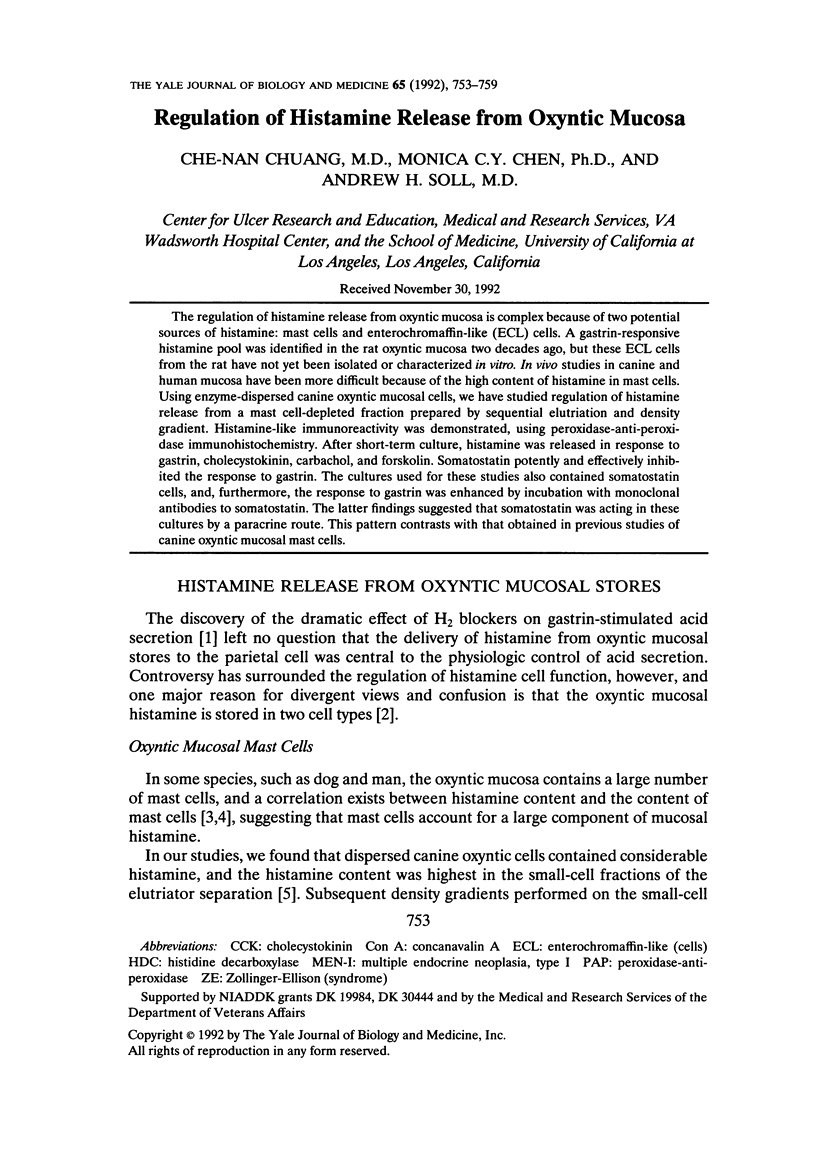
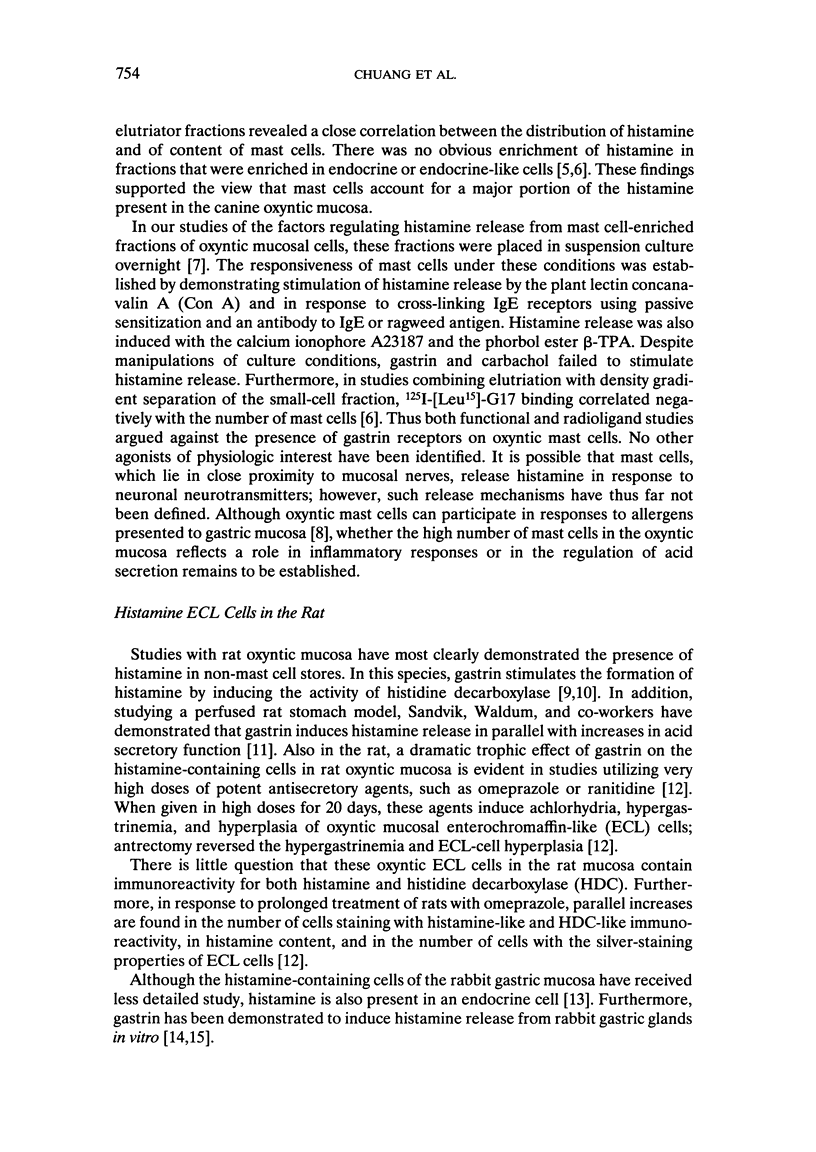
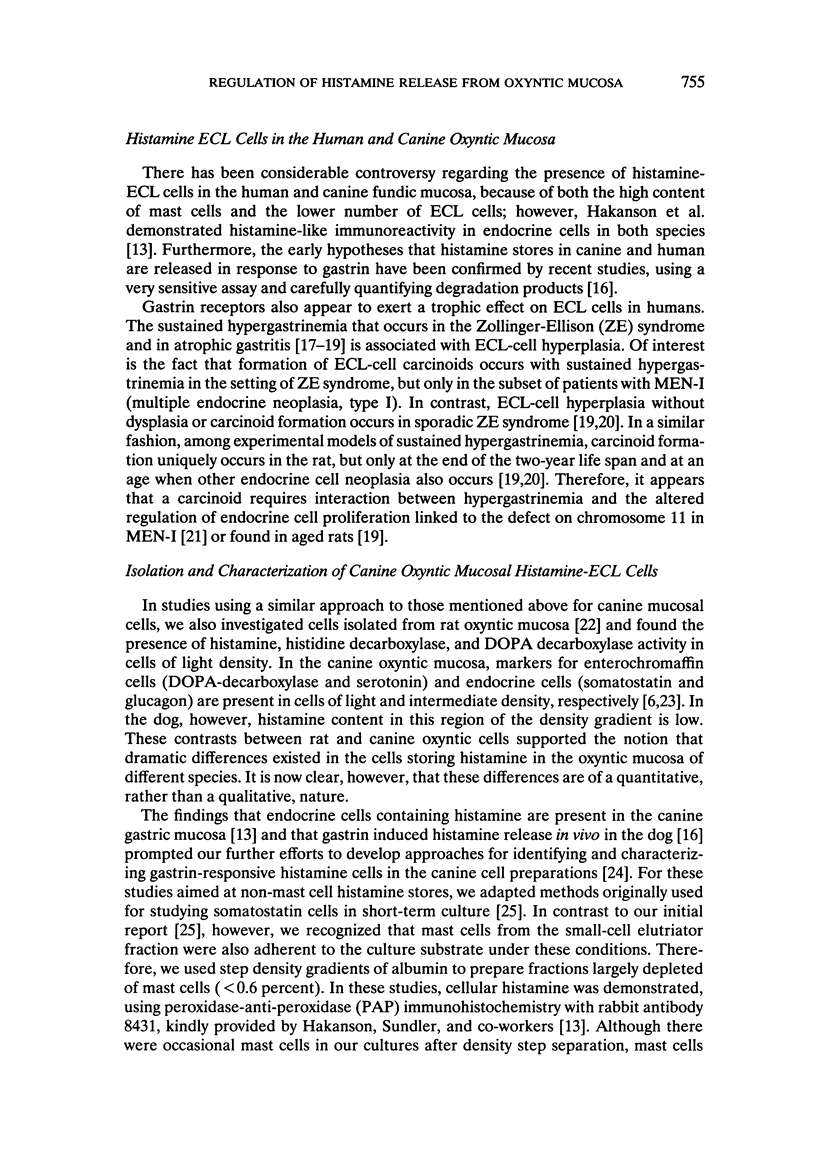
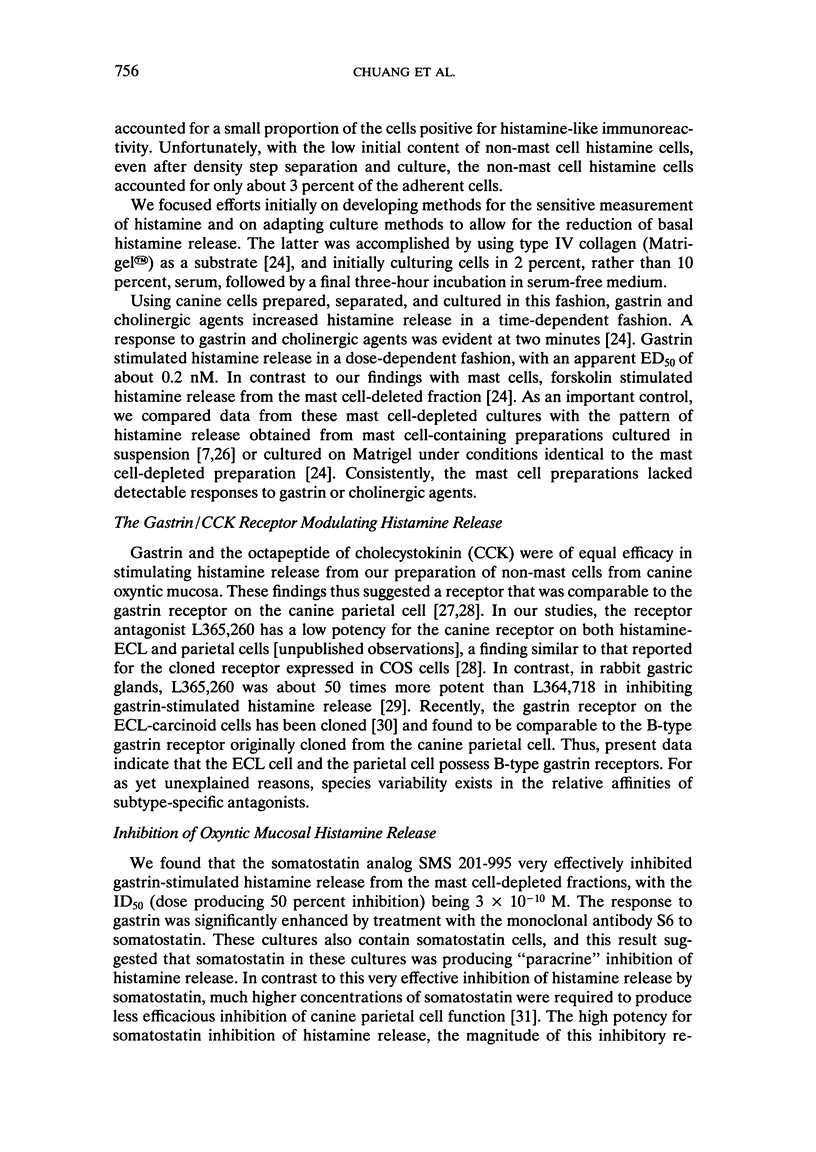
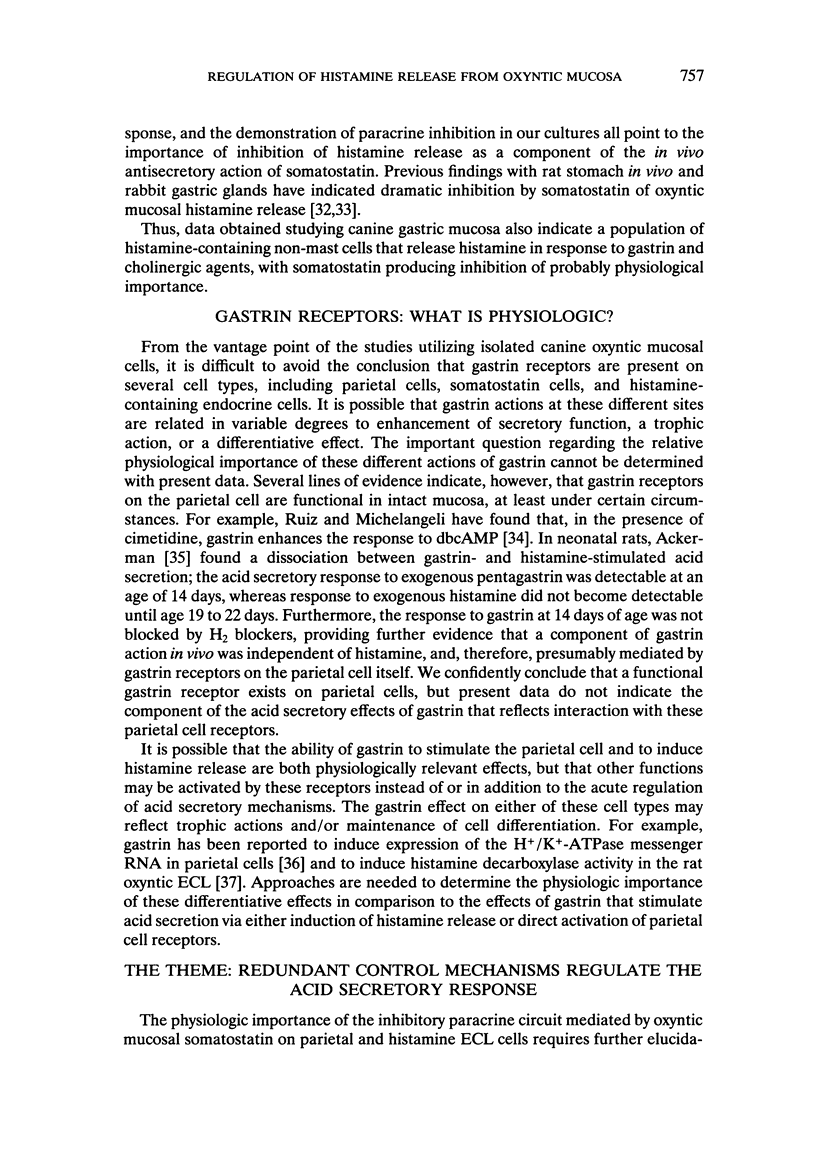
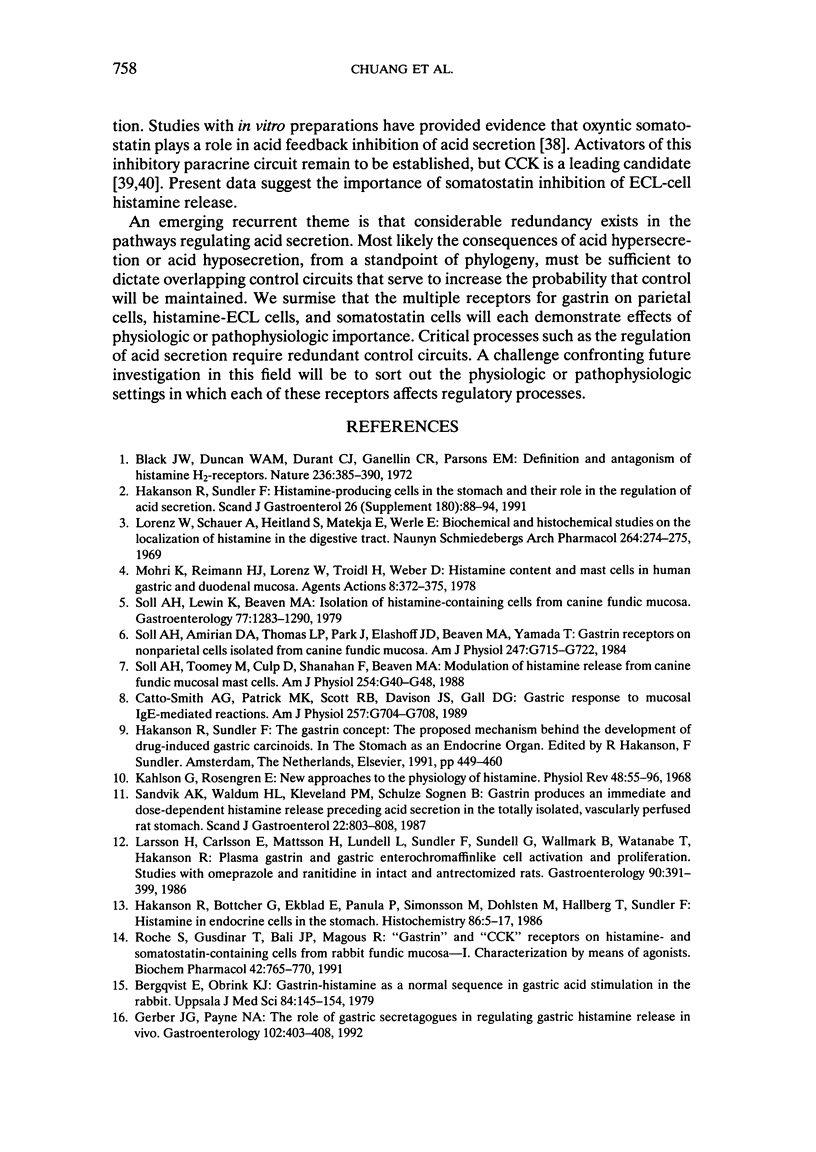
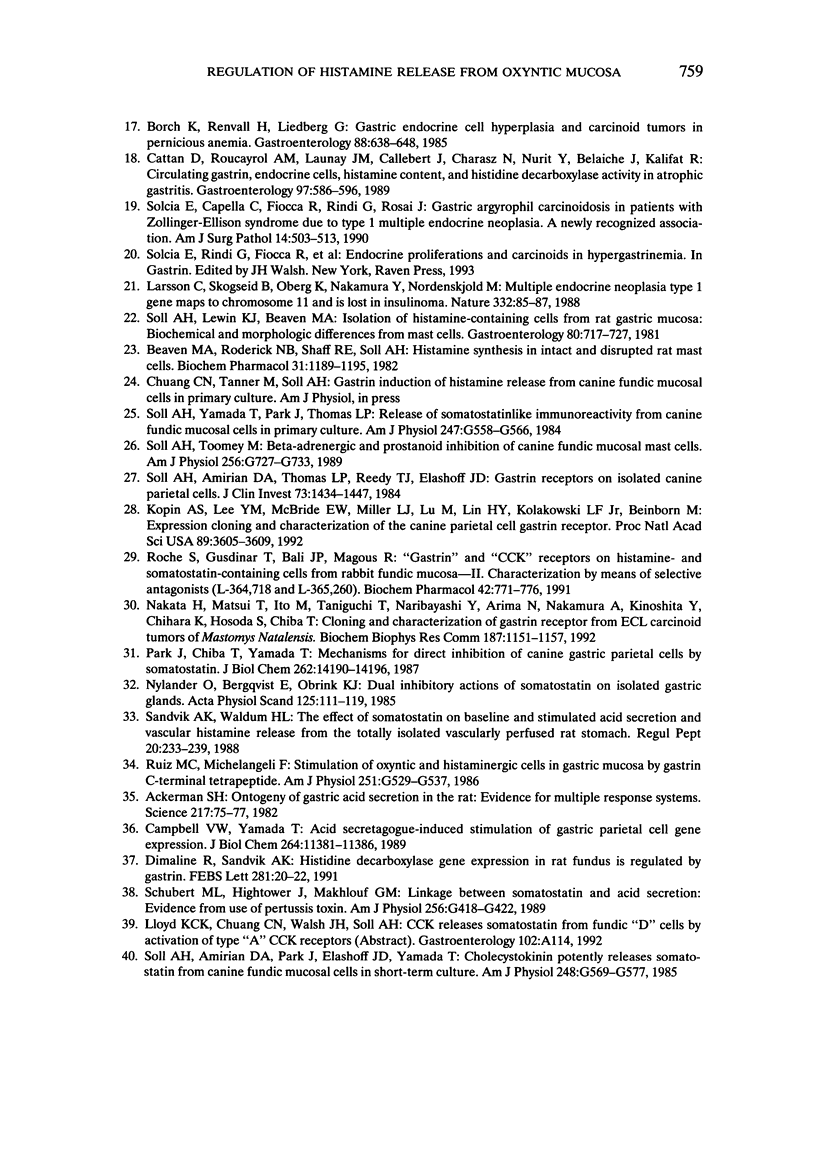
Selected References
These references are in PubMed. This may not be the complete list of references from this article.
- Ackerman S. H. Ontogeny of gastric acid secretion in the rat: evidence for multiple response systems. Science. 1982 Jul 2;217(4554):75–77. doi: 10.1126/science.6211765. [DOI] [PubMed] [Google Scholar]
- Beaven M. A., Roderick N. B., Shaff R. E., Soll A. H. Histamine synthesis in intact and disrupted rat mast cells. Biochem Pharmacol. 1982 Apr 1;31(7):1189–1195. doi: 10.1016/0006-2952(82)90003-x. [DOI] [PubMed] [Google Scholar]
- Bergqvist E., Obrink K. J. Gastrin-histamine as a normal sequence in gastric acid stimulation in the rabbit. Ups J Med Sci. 1979;84(2):145–154. doi: 10.3109/03009737909179150. [DOI] [PubMed] [Google Scholar]
- Black J. W., Duncan W. A., Durant C. J., Ganellin C. R., Parsons E. M. Definition and antagonism of histamine H 2 -receptors. Nature. 1972 Apr 21;236(5347):385–390. doi: 10.1038/236385a0. [DOI] [PubMed] [Google Scholar]
- Borch K., Renvall H., Liedberg G. Gastric endocrine cell hyperplasia and carcinoid tumors in pernicious anemia. Gastroenterology. 1985 Mar;88(3):638–648. doi: 10.1016/0016-5085(85)90131-3. [DOI] [PubMed] [Google Scholar]
- Campbell V. W., Yamada T. Acid secretagogue-induced stimulation of gastric parietal cell gene expression. J Biol Chem. 1989 Jul 5;264(19):11381–11386. [PubMed] [Google Scholar]
- Cattan D., Roucayrol A. M., Launay J. M., Callebert J., Charasz N., Nurit Y., Belaiche J., Kalifat R. Circulating gastrin, endocrine cells, histamine content, and histidine decarboxylase activity in atrophic gastritis. Gastroenterology. 1989 Sep;97(3):586–596. doi: 10.1016/0016-5085(89)90628-8. [DOI] [PubMed] [Google Scholar]
- Catto-Smith A. G., Patrick M. K., Scott R. B., Davison J. S., Gall D. G. Gastric response to mucosal IgE-mediated reactions. Am J Physiol. 1989 Nov;257(5 Pt 1):G704–G708. doi: 10.1152/ajpgi.1989.257.5.G704. [DOI] [PubMed] [Google Scholar]
- Dimaline R., Sandvik A. K. Histidine decarboxylase gene expression in rat fundus is regulated by gastrin. FEBS Lett. 1991 Apr 9;281(1-2):20–22. doi: 10.1016/0014-5793(91)80348-7. [DOI] [PubMed] [Google Scholar]
- Gerber J. G., Payne N. A. The role of gastric secretagogues in regulating gastric histamine release in vivo. Gastroenterology. 1992 Feb;102(2):403–408. doi: 10.1016/0016-5085(92)90083-b. [DOI] [PubMed] [Google Scholar]
- Håkanson R., Böttcher G., Ekblad E., Panula P., Simonsson M., Dohlsten M., Hallberg T., Sundler F. Histamine in endocrine cells in the stomach. A survey of several species using a panel of histamine antibodies. Histochemistry. 1986;86(1):5–17. doi: 10.1007/BF00492340. [DOI] [PubMed] [Google Scholar]
- Håkanson R., Sundler F. Histamine-producing cells in the stomach and their role in the regulation of acid secretion. Scand J Gastroenterol Suppl. 1991;180:88–94. doi: 10.3109/00365529109093183. [DOI] [PubMed] [Google Scholar]
- Kopin A. S., Lee Y. M., McBride E. W., Miller L. J., Lu M., Lin H. Y., Kolakowski L. F., Jr, Beinborn M. Expression cloning and characterization of the canine parietal cell gastrin receptor. Proc Natl Acad Sci U S A. 1992 Apr 15;89(8):3605–3609. doi: 10.1073/pnas.89.8.3605. [DOI] [PMC free article] [PubMed] [Google Scholar]
- Larsson C., Skogseid B., Oberg K., Nakamura Y., Nordenskjöld M. Multiple endocrine neoplasia type 1 gene maps to chromosome 11 and is lost in insulinoma. Nature. 1988 Mar 3;332(6159):85–87. doi: 10.1038/332085a0. [DOI] [PubMed] [Google Scholar]
- Larsson H., Carlsson E., Mattsson H., Lundell L., Sundler F., Sundell G., Wallmark B., Watanabe T., Håkanson R. Plasma gastrin and gastric enterochromaffinlike cell activation and proliferation. Studies with omeprazole and ranitidine in intact and antrectomized rats. Gastroenterology. 1986 Feb;90(2):391–399. doi: 10.1016/0016-5085(86)90938-8. [DOI] [PubMed] [Google Scholar]
- Lorenz W., Schauer A., Heitland S., Matekja E., Werle E. Biochemical and histochemical studies on the localization of histamine in the digestive tract. Naunyn Schmiedebergs Arch Pharmakol. 1969;264(3):274–275. doi: 10.1007/BF02431471. [DOI] [PubMed] [Google Scholar]
- Mohri K., Reimann H. J., Lorenz W., Troidl H., Weber D. Histamine content and mast cells in human gastric and duodenal mucosa. Agents Actions. 1978 Jun;8(4):372–375. doi: 10.1007/BF01968617. [DOI] [PubMed] [Google Scholar]
- Nakata H., Matsui T., Ito M., Taniguchi T., Naribayashi Y., Arima N., Nakamura A., Kinoshita Y., Chihara K., Hosoda S. Cloning and characterization of gastrin receptor from ECL carcinoid tumor of Mastomys natalensis. Biochem Biophys Res Commun. 1992 Sep 16;187(2):1151–1157. doi: 10.1016/0006-291x(92)91317-j. [DOI] [PubMed] [Google Scholar]
- Nylander O., Bergqvist E., Obrink K. J. Dual inhibitory actions of somatostatin on isolated gastric glands. Acta Physiol Scand. 1985 Sep;125(1):111–119. doi: 10.1111/j.1748-1716.1985.tb07697.x. [DOI] [PubMed] [Google Scholar]
- Park J., Chiba T., Yamada T. Mechanisms for direct inhibition of canine gastric parietal cells by somatostatin. J Biol Chem. 1987 Oct 15;262(29):14190–14196. [PubMed] [Google Scholar]
- Roche S., Gusdinar T., Bali J. P., Magous R. "Gastrin" and "CCK" receptors on histamine- and somatostatin-containing cells from rabbit fundic mucosa--I. Characterization by means of agonists. Biochem Pharmacol. 1991 Jul 25;42(4):765–770. doi: 10.1016/0006-2952(91)90034-3. [DOI] [PubMed] [Google Scholar]
- Roche S., Gusdinar T., Bali J. P., Magous R. "Gastrin" and "CCK" receptors on histamine- and somatostatin-containing cells from rabbit fundic mucosa-II. Characterization by means of selective antagonists (L-364,718 and L-365,260). Biochem Pharmacol. 1991 Jul 25;42(4):771–776. doi: 10.1016/0006-2952(91)90035-4. [DOI] [PubMed] [Google Scholar]
- Ruiz M. C., Michelangeli F. Stimulation of oxyntic and histaminergic cells in gastric mucosa by gastrin C-terminal tetrapeptide. Am J Physiol. 1986 Oct;251(4 Pt 1):G529–G537. doi: 10.1152/ajpgi.1986.251.4.G529. [DOI] [PubMed] [Google Scholar]
- Sandvik A. K., Waldum H. L., Kleveland P. M., Schulze Søgnen B. Gastrin produces an immediate and dose-dependent histamine release preceding acid secretion in the totally isolated, vascularly perfused rat stomach. Scand J Gastroenterol. 1987 Sep;22(7):803–808. doi: 10.3109/00365528708991918. [DOI] [PubMed] [Google Scholar]
- Sandvik A. K., Waldum H. L. The effect of somatostatin on baseline and stimulated acid secretion and vascular histamine release from the totally isolated vascularly perfused rat stomach. Regul Pept. 1988 Mar;20(3):233–239. doi: 10.1016/0167-0115(88)90079-1. [DOI] [PubMed] [Google Scholar]
- Schubert M. L., Hightower J., Makhlouf G. M. Linkage between somatostatin and acid secretion: evidence from use of pertussis toxin. Am J Physiol. 1989 Feb;256(2 Pt 1):G418–G422. doi: 10.1152/ajpgi.1989.256.2.G418. [DOI] [PubMed] [Google Scholar]
- Solcia E., Capella C., Fiocca R., Rindi G., Rosai J. Gastric argyrophil carcinoidosis in patients with Zollinger-Ellison syndrome due to type 1 multiple endocrine neoplasia. A newly recognized association. Am J Surg Pathol. 1990 Jun;14(6):503–513. doi: 10.1097/00000478-199006000-00001. [DOI] [PubMed] [Google Scholar]
- Soll A. H., Amirian D. A., Park J., Elashoff J. D., Yamada T. Cholecystokinin potently releases somatostatin from canine fundic mucosal cells in short-term culture. Am J Physiol. 1985 May;248(5 Pt 1):G569–G573. doi: 10.1152/ajpgi.1985.248.5.G569. [DOI] [PubMed] [Google Scholar]
- Soll A. H., Amirian D. A., Thomas L. P., Park J., Elashoff J. D., Beaven M. A., Yamada T. Gastrin receptors on nonparietal cells isolated from canine fundic mucosa. Am J Physiol. 1984 Dec;247(6 Pt 1):G715–G723. doi: 10.1152/ajpgi.1984.247.6.G715. [DOI] [PubMed] [Google Scholar]
- Soll A. H., Amirian D. A., Thomas L. P., Reedy T. J., Elashoff J. D. Gastrin receptors on isolated canine parietal cells. J Clin Invest. 1984 May;73(5):1434–1447. doi: 10.1172/JCI111348. [DOI] [PMC free article] [PubMed] [Google Scholar]
- Soll A. H., Lewin K. J., Beaven M. A. Isolation of histamine-containing cells from rat gastric mucosa: biochemical and morphologic differences from mast cells. Gastroenterology. 1981 Apr;80(4):717–727. [PubMed] [Google Scholar]
- Soll A. H., Lewin K., Beaven M. A. Isolation of histamine-containing cells from canine fundic mucosa. Gastroenterology. 1979 Dec;77(6):1283–1290. [PubMed] [Google Scholar]
- Soll A. H., Toomey M. Beta-adrenergic and prostanoid inhibition of canine fundic mucosal mast cells. Am J Physiol. 1989 Apr;256(4 Pt 1):G727–G732. doi: 10.1152/ajpgi.1989.256.4.G727. [DOI] [PubMed] [Google Scholar]
- Soll A. H., Toomey M., Culp D., Shanahan F., Beaven M. A. Modulation of histamine release from canine fundic mucosal mast cells. Am J Physiol. 1988 Jan;254(1 Pt 1):G40–G48. doi: 10.1152/ajpgi.1988.254.1.G40. [DOI] [PubMed] [Google Scholar]
- Soll A. H., Yamada T., Park J., Thomas L. P. Release of somatostatinlike immunoreactivity from canine fundic mucosal cells in primary culture. Am J Physiol. 1984 Nov;247(5 Pt 1):G558–G566. doi: 10.1152/ajpgi.1984.247.5.G558. [DOI] [PubMed] [Google Scholar]


